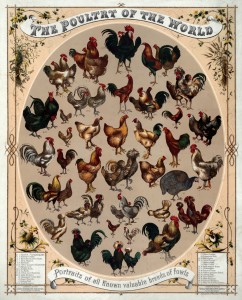A UNEP press release about the launch of the “Kenya: Atlas of Our Changing Environment” led me to the website of the global project to which the Kenya publication contributes. It does include agriculture and aquaculture: check out the drop-down menu in the top right-hand corner. You click on the icon on the map and get more information on specific sites, such as Balanta rice farming in Guinea-Bissau, for example. You can download imagery and leave comments about each site.
Blogging the big birthday: Chickens of the world
I’d like to think Darwin might have had this poster, or something like it, in mind as he wrote the following words in the Domestication. But then he would have acknowledged it. He was meticulous about that.
As some naturalists may not be familiar with the chief breeds of the fowl, it will be advisable to give a condensed description of them. From what I have read and seen of specimens brought from several quarters of the world, I believe that most of the chief kinds have been imported into England, but many sub-breeds are probably still here unknown. The following discussion on the origin of the various breeds and on their characteristic differences does not pretend to completeness, but may be of some interest to the naturalist. The classification of the breeds cannot, as far as I can see, be made natural. They differ from each other in different degrees, and do not afford characters in subordination to each other, by which they can be ranked in group under group. They seem all to have diverged by independent and different roads from a single type.
The poultry of the world. Portraits of all known valuable breeds of fowl. Fifty-two types of identified chickens. Chromolithograph by L. Prang & Co., Boston, ca. 1868. From the Performing Arts Poster Collection at the U.S. Library of Congress. [PD] This picture is in the public domain. Downloaded from flickr.
Blogging the big birthday: Darwin’s last hurrah
Jacob van Etten’s contribution to the birthday celebrations…
“Darwin must die,” writes Carl Safina on the occasion of the man’s 200th birthday. Darwin shouldn’t take it personally. Safina means to say that Darwinism stands in the way of fully appreciating the value of modern biology.
“Darwinism†implies an ideology adhering to one man’s dictates, like Marxism. Charles Darwin didn’t invent a belief system. He had an idea, not an ideology. Our understanding of how life works since Darwin won’t swim in the public pool of ideas until we kill the cult of Darwinism.
I agree. And there is more.
Darwin’s biographer, Janet Browne, illuminates another aspect of Darwinian science. 1 Darwin collected much of his data by writing letters, many letters. He requested information from all kinds of people, fellow naturalists, but also farmers, breeders, civil servants and army officers. Some 14,000 of the letters Darwin wrote or received have been stored in libraries, and many more may have been lost. What Browne describes is something that verges on systematic exploitation.
The flow of information [Darwin] initiated was almost always one-way. Darwin regarded his correspondence primarily as a supply system, designed to answer his own wants. There was no doubt the legitimacy of this one-way arrangement. After all, he occupied an assured place in the intellectual elite, at the heart of an expanding scientific and social meritocracy that in turn lay at the hub of one of the most powerful and systematically organised empires known to history.
Darwin’s 200th birthday is a good occasion not only to do away with Darwin, but also with the whole idea of Big Man science. So, kill Darwin, and Vavilov, too. Make science a collaborative, reciprocal learning effort. Welcome Science 2.0. Each farm is an evolutionary biology lab. Everybody is a scientist.
Nibbles: Hell, Honours, Pollution, Darwin, Genomes, Small companies, Tigernuts, Urine soft drink, Medicinal plants
- A way out of hell: workshop on Database Challenges in Biodiversity Informatics
- Potato man honoured.
- Farm diversity reduces nitrogen runoff.
- Darwin on the Farm, from our friends at the Global Crop Diversity Trust.
- Yeast and wheat genome sequencing going gangbusters.
- Coffee!
- Fermented tigernuts more nutritious? No, they’re not from an endangered species. Via.
- Cow water!
- Lots of medicinal plants conservation projects going on in India.
Nibbles: Wine, Ass, Maps, Mauka, Pest management, Photos
- Mathilda on domestication of the vine and donkey.
- New software for species mapping is out: Croziat.
- Another day, another tuber.
- Using Diversity as a Pest Management Tool. There’s a thought.
- Pix of West African plants, including cultivated, with lots of assorted link goodness.
